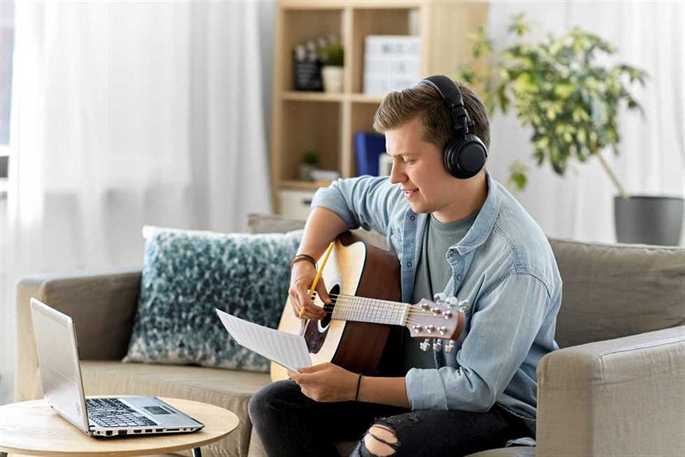Online Clarinet Lessons
 What is a clarinet? To paraphrase Mark van de Wiel, the principal clarinetist of London’s Philharmonia Orchestra, “The clarinet is basically a cylindrical, wooden tube with finger holes and metal keys.” This reductive description, spoken by one of the world’s greatest living clarinetists, is part of what makes the clarinet so charming and wonderful. The instrument can serve as part of the greater ensemble or as a solo instrument, but the humility and passion with which Mark speaks tells of the dedication and hours that he’s put into learning it.
What is a clarinet? To paraphrase Mark van de Wiel, the principal clarinetist of London’s Philharmonia Orchestra, “The clarinet is basically a cylindrical, wooden tube with finger holes and metal keys.” This reductive description, spoken by one of the world’s greatest living clarinetists, is part of what makes the clarinet so charming and wonderful. The instrument can serve as part of the greater ensemble or as a solo instrument, but the humility and passion with which Mark speaks tells of the dedication and hours that he’s put into learning it.
With our help and your passion, the Academy of Music can offer a deeply rewarding, enriching learning experience via our online clarinet lessons. Let’s walk you through history and provide a textured, personalized, highly stimulating musical journey while unlocking your full potential!
Clarinet History
The clarinet is thought to have been created in the year 1700. It’s believed that it was produced in response to specific needs from Late Baroque-era composers, who needed their trumpet or clarino players to reach high registers; these became known as clarion (the diminutive of clarino) registers, and from that the word clarinet was derived. It’s also where we get the phrase “clarion call.”
How it Works
The noises created by the clarinet come from making vibrations in the reed, a thin strip of material tapered off towards the end, typically made of cane grasses but sometimes synthetic material. The reed vibrates when air passes over it, and those vibrations make the sound that the clarinet produces, which can be adjusted using the tone holes and keys on the instrument. You can see how reeds make sound yourself in the wild by grabbing tall grass and trying to make sounds with it by creating a seal with your thumbs around the grass, putting your lips to your thumbs and blowing over it. To ensure the proper sound, you need the proper reed, so travelling clarinetists will often bring a large assortment of different reeds with them from concert hall to concert hall. Acoustics, ambient temperature, humidity, and other conditions might affect the reed the concert clarinetist will use on a given night.
Of course, the body of the clarinet serves to make its sounds much more beautiful and varied than those you could make by blowing over a blade of grass. There is a barrel at the top which can be adjusted to elongate the clarinet, creating micro-shifts in its pitch. The body is divided into the upper joint, whose keys and holes are usually manipulated using the left hand, and the lower joint, manipulated using the right. The tone holes and some keys are used to create a variety of notes, while other keys might be used to create trills, rapid switching between a variety of notes. In order to stop notes, clarinetists will use their tongues to block vibrations from going through the reed, taking the tongue off this component when they want sound to be produced again.
Sizing
Clarinets come in a wide variety of sizes in order to produce different notes. The most common clarinets are in B and A. Those two types are used so frequently in composition that most concert clarinetists will have both instruments with them for a concert; they may sometimes need to swap clarinets extremely quickly, even in the middle of the same piece! For an instrument Mark spoke about so humbly, clarinetists have to refine a great number of techniques in order to play successfully.
Why Play the Clarinet?
There are plenty of reasons, and they extend well beyond an affinity for the Spongebob Squarepants character Squidward (who wasn’t really a formidable clarinetist to begin with). The clarinet has a storied history in Western music; as mentioned, it’s been used in classical composition since at least the year 1700, and is so useful in these competitions that clarinetists need to carry two with them. What a lot of folks might not realize is that the clarinet isn’t just used in classical; the instrument has been used prominently in jazz compositions for years. Duke Ellington famously composed a variety of tunes using lead clarinet, and a variety of big band composers used featured the instrument prominently. The clarinet also features prominently is some famous rock arrangements; Sly and the Family Stone’s “Dance to the Music” might be one of the funkiest songs to use the clarinet. Avant-garde and experimental rock composers also love the tones from the clarinet. For instance, you can hear the instrument in Radiohead’s jazz-influenced “Life in a Glasshouse” and Tom Waits “All the World is Green”.
Your Signature Sound
No matter what kind of music you like, there’s songs on the clarinet for you to play. If you’re interested in learning an instrument with a vast repertoire that most people can’t play (how many clarinetists do you know?), the clarinet is an excellent choice. The instrument is incredibly rewarding to learn, because everything from the position of your tongue to the quality of your breath affects tone and pitch. This is an instrument that rewards discipline and dedication, allowing you to make the experience unique to you.
Every clarinetist will sound a little bit different as well, so it’ll also sound uniquely like you! This happens because everyone’s personal experience will influence how they play their instrument, every reed is constructed a little differently, and each clarinet might produce a slightly different sound. Therefore, when you learn the clarinet, you’re learning to play music that’s a unique reflection of you. You’ll have to learn fingerings, how to use the tone holes as well as the metal keys, and methods of blowing into the instrument just so. This will teach you patience, dexterity, breath control, and even a bit of self-love. You’ll grow more confident as this reflection of you becomes more nuanced, more subtle, more fierce, more beautiful.
Our Online Clarinet Lessons: A Great Choice for All Ages
All of these benefits apply to children, too, who tend to be better at picking up musical habits because of their neuroplasticity. That means the earlier you pick up the clarinet, the faster these good habits will form; who doesn’t want their child to learn a skill that builds up their confidence and self-awareness? At the same time, adults can certainly learn if they have the drive and ambition to do so, and we love to work with all age groups and backgrounds at the Academy of Music.
That’s why we offer online clarinet lessons. You can learn from the comfort of your own home, or have your child learn without worrying about driving them across the city for an appointment. While you cook dinner, do chores, or find a bit of time for yourself, you’ll be able to hear your child develop, both musically and personally. Our techniques compound on each other, so each step of the process reveals more depth in the others, until clarinet mastery is achieved. This is the case whether you’re 10, 60, or any other age – talent doesn’t discriminate!
Beginner, Pro, or Somewhere in Between? We’re an Ideal Choice!
For students new to the clarinet, we use the Hal Leonard Essential Elements system. We like this system because of its focus on multiple mediums to teach. It uses videos, songs, text and more, so no matter what kind of learning is easiest for you, there’s something you’ll be able to get out of the Hal Leonard courses. The courses delve into music theory, rhythm, and practice. We also offer courses for the Royal Conservatory of Music program, the gold standard for professional musicians. Passing their exams is difficult, a true rite of passage, but we’ll ensure you have all the tools and techniques necessary to succeed.
We’re also happy to customize your experience. Our instructors can personalize a program of study that best suits the needs of the student, whether to get a head start with a school band program, reinforce and supplement a current school band program, prepare for a university music program, or just for fun! We’re happy to help you learn anything in the clarinet’s vast repertoire, so give this wonderful instrument a try. We can’t wait to share its magic with you!

Frequently Asked Questions
Why should I take online clarinet lessons?
If you’re interested in learning a new instrument in a supportive, friendly and welcoming digital environment, our online clarinet lessons are a great choice! It’s a chance to have fun, make memories, expand your abilities, or simply even dabble in something new. In the sense of the latter, that means focusing on positive and stimulating activity while polishing practical instrumental skills. With our help, your patience and willpower, and the power of music to bring people together, we’ll have a great time and enable you to experience the wonders of clarinet mastery across multiple sessions.
Do you have options for kids and adults?
Of course! You’re never too young or old to take a crack at the chords. Learning an instrument such as the clarinet affords a stimulating and exciting new experience, and the Academy of Music makes it ideal for all ages. Our online clarinet lessons are offered in a variety of focuses for the clarinet alone, so we can cater our programming based on what interests you. Reach out to us today to learn more about your options!
Do I need an instrument?
Yes! It’s necessary that you provide your own instrument for our online lessons. We’d definitely recommend getting a hold of even a basic, low-cost clarinet before getting started. You don’t need anything fancy or to make great music with us! An ideal option for those on a budget is to purchase a used instrument. Some music colleges and stores make them readily available, and you may be able to find a great price on a clarinet as more people learning may lead to more interest in their products and services. It’s a win-win for everyone!
Are online clarinet lessons as effective as in-person ones?
With us? Definitely! Despite starting out as a local in-person purveyor of music lessons across a myriad of instruments, the times are changing like notes on a scale. We don’t want to “B-flat” – pun intended – and miss out on providing a great learning experience to more people! That’s why our Facetime, Zoom, and Skype clarinet lessons adopt the same comprehensive and exciting programming structure as our in-person ones, made possible by advances in communications technology. We love to work with students in person and meet them, but e-meeting us is an excellent option for those who don’t live near our locations or prefer remote lessons. Reach out to us if you have any questions – we’re glad to help!



